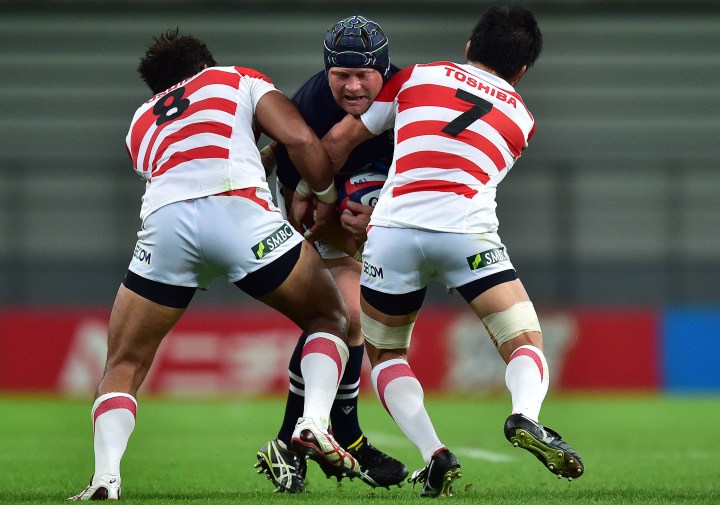SPORT
Foreign franchise: South African rugby suffers a player exodus

An increasing number of South African names are appearing on team lists from countries such as Scotland and Italy, underlining the large volume of South Africa’s player drain.
Durban-born Bradley Roberts is set to make his Test debut for Wales against the Springboks in Cardiff on 6 November. The Ulster hooker – who was schooled in KwaZulu-Natal and attended university in Stellenbosch before moving to Ireland for the sake of his rugby career – qualifies for the Dragons thanks to a Welsh grandmother. Roberts was rushed into the Wales squad recently after the team sustained a series of injuries in the front-row department.
On 13 November, the Boks will face a Scotland side featuring a number of familiar faces. Current Scotland squad members such as Oli Kebble, Dylan Richardson, Pierre Schoeman, Kyle Steyn and Duhan van der Merwe were all born and schooled in South Africa. They began their professional careers with a Super Rugby or Currie Cup team. Apart from Steyn, each represented South Africa at Under-20 level.
Several other Test teams competing in the northern hemisphere this November boast their own South Africa-born stars. Since representing hosts Japan at the 2019 World Cup, Lappies Labuschagne has led the Brave Blossoms. Bernard le Roux and Paul Willemse have been at the heart of France’s resurgence in recent years, while Rob Herring and Braam Steyn have featured regularly for Ireland and Italy respectively. These players began their professional careers in South Africa before pursuing opportunities overseas.
According to SA Rugby’s records, more than 200 South Africans have represented other Test nations since 1896. That may not seem like a significant number when one measures the rate of representation over a period of 125 years.
What’s interesting to note is that 68% of those South Africans have made their debut for an adopted nation in the professional era – from 1996 onwards. A whopping 40% have won their first cap for a foreign nation since the start of the 2010 season.
It’s not hard to understand why so many South Africans have represented overseas teams at international and club level over the past decade or so. Given the exchange rate, few turn down the chance to earn salaries paid in pounds, euros or yen. SA Rugby CEO Jurie Roux put the matter into perspective in early 2018.
“When a player gets a great offer from abroad, we can’t compete with the money and the opportunities to go and play in another country,” he said. “There are tax and other benefits too, as well as the lure of residency and passports from other countries.”
Since 2010, more and more South African players have defected to English, French and Italian clubs. Irish, Scottish and Welsh sides have increased their intake. Japan, considered an exotic option some 10 to 15 years ago, is now a premier destination.
Recently, the US and Russia have bolstered their domestic leagues and, in the case of Russia, looked to recruit players from SA who can eventually qualify for the national team.
A recent DM168 report highlighted the fact that nearly 200 of South Africa’s best players are plying their trade for elite clubs in Europe and Japan. While Bok coach Jacques Nienaber is free to draw on this pool of players – and has selected 16 overseas-based players for the current tour to the UK – it’s plain to see how the exodus has depleted the depth of the South African franchises.
Geographical location and previous Test experience are no longer prerequisites for selection. Cheslin Kolbe, Rynhardt Elstadt and Jasper Wiese, to name a few, were based abroad when they were first selected by the Boks. That trend is likely to continue, given the high number of players – many of them youngsters – based overseas. Some players, as Roux suggests, have moved abroad to qualify for a foreign nation after completing the mandatory three-year residency period.

Duhan van der Merwe of the British & Irish Lions charges upfield during the 3rd Test match between the South African Springboks and the British & Irish Lions at Cape Town Stadium on 7 August 2021. (Photo: David Rogers / Getty Images)
Residency and eligibility rules
Consider the group of South Africa-born players on show for other Test teams over the next few weeks. Herring, Roberts, Richardson and Steyn all qualify for their adopted nations thanks to the nationality of a parent or grandparent.
The rest – Labuschagne for Japan; Le Roux and Willemse for France; Kebble, Schoeman and Van der Merwe for Scotland – qualified for their respective teams after spending three years in that country.
World Rugby’s residency rule has been a hot point of debate over the past few years.
While some in Ireland have lauded the influence of the “Project Players” – players from countries such as New Zealand and South Africa who have been recruited by Irish clubs and groomed for the national side – others have called for local players to receive preference.
Ten South Africa-born players have represented Scotland in recent years – namely Alan Dell, Cornell du Preez, Tyrone Holmes, Kebble, WP Nel, Schoeman, Josh Strauss, Steyn, Van der Merwe and Jaco van der Walt.
Steyn scored four tries against Tonga recently, while Kebble and Schoeman also crossed the whitewash in the 60-14 rout. In the aftermath, several commentators in the UK expressed their concern that all of the try-scorers were born or developed outside Scotland.
Here in South Africa, the lament is that these South Africa-born players are not turning out for the Boks.
While it is certainly a shame that hundreds of South Africans have been lost to the franchise system, and that the local game has been weakened as a result, it would be a stretch to claim that all of these players would have played Test rugby if they had remained in their home country.
Back in 2012, then Bok coach Heyneke Meyer told Nel that he wasn’t among the top three tighthead props in South Africa, and thus not in the frame for national selection.
This influenced Nel’s decision to move to Edinburgh and eventually realise his dream of playing Test rugby, albeit for Scotland. Others – Ireland’s CJ Stander for one – have followed this route after finding their path blocked in South Africa.
World Rugby will demand a greater commitment from players looking to represent an adopted nation in future. The residency qualification period will be extended from three to five years from 31 December 2021.
It remains to be seen how this will affect South African rugby, and whether players will leave for Europe at a younger age in order to qualify for an adopted Test team by their mid- to late twenties.
What’s more, World Rugby will meet later this month to discuss changes to the eligibility law that will allow players who have already been capped by one nation to represent the country of their or their ancestors’ birth following a three-year stand-down period.
The World Rugby council will discuss the proposals at the next meeting on 24 November, with a 75% majority, or 39 of 52 votes, required for the ruling to pass.
Malakai Fekitoa and Charles Piutau, who have both played for the All Blacks, will be available for their home nation of Tonga should the changes come into effect. It’s possible that both players will feature for Tonga in the 2023 World Cup.
Under the proposal, players would also only be entitled to one switch of nationality in their careers and they would require a “close and credible” link to another country through lineage.
If it passes, any capped Bok players who have not played Test rugby for three or more years, and who have credible links to another nation, will also be eligible for a comeback to the international arena.
With all of this in mind, it wouldn’t surprise to see an even larger South African contingent on display at the 2023 World Cup, outside of the players wearing green and gold. DM168
This story first appeared in our weekly Daily Maverick 168 newspaper which is available for R25 at Pick n Pay, Exclusive Books and airport bookstores. For your nearest stockist, please click here.



















 Become an Insider
Become an Insider
A different interpretation of the same set of facts. SA has a very good system for training and developing rugby players who are in high demand in much of the rugby playing world. We produce far more quality rugby players than we need for our local “rugby industry”. The SA “rugby industry” is not as big/profitable as other countries and has its own unique characteristics such as rugby development, supporting amateur rugby, etc. Not all the good players we produce can play for SA, so its only fair that they be allowed to play for other countries if they want to play international rugby. The influence of SA & NZ trained rugby players has had massive impact on quality of rugby in Ireland, France, Scotland and Japan, and thus their national sides, which increase the entertainment value of international games. We are still able to win world cups, so the “quality” of the Springboks have not suffered too much despite the losses of these potential players to the Springboks. Many if not most of these players will return to SA once their playing careers are over, so their experience can add value to SA rugby as coaches and mentors.